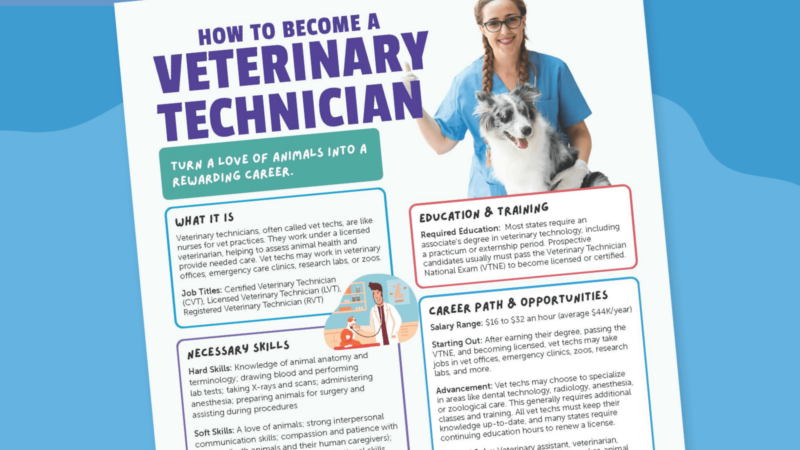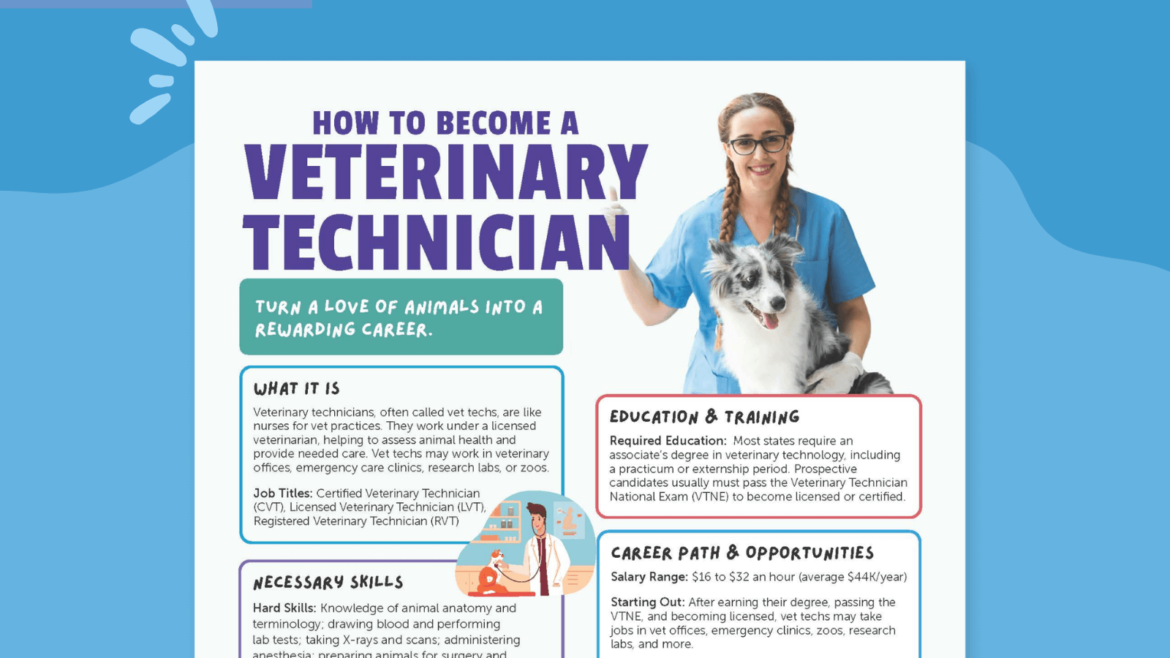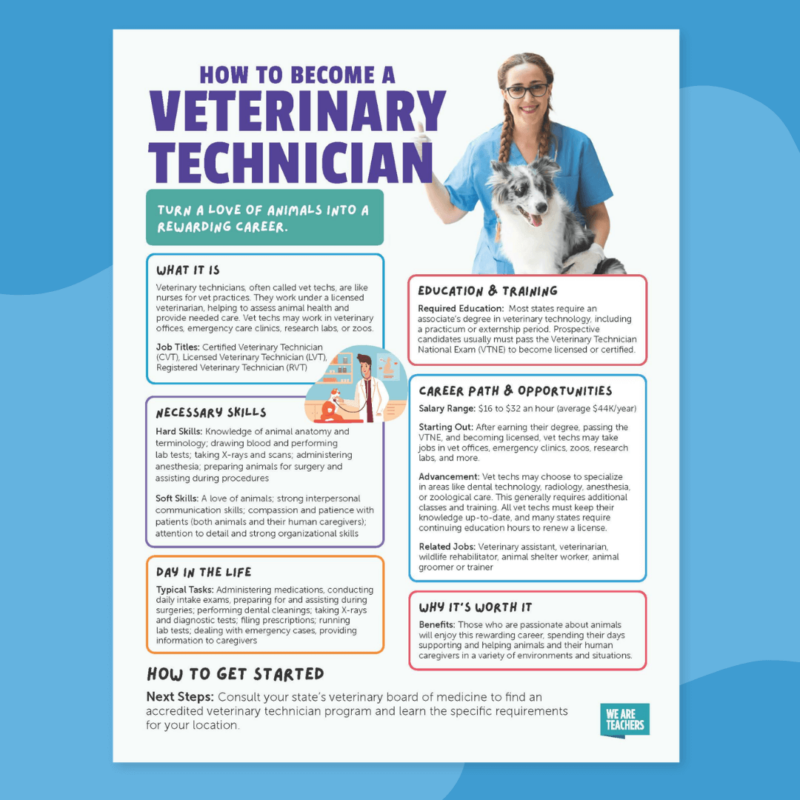There’s something special about our relationships with animals, from pet dogs, cats, and hamsters to farm animals like horses, cows, and chickens. Lots of students dream of working with animals as a career, but becoming a full-fledged veterinarian takes a lot of time and money. Veterinary technicians (also known as vet techs and veterinary aids) are ready to join the workforce much sooner, without as much expense involved. Here’s how to become a vet tech, plus some FAQs with advice from a real expert in the field.
How To Become a Vet Tech FAQs
What is a veterinary technician?
Think of a vet tech as an animal nurse. They assist veterinarians in caring for animals of all shapes and sizes by performing tests, processing lab work, prepping animals for surgery, and much more. They may work in veterinary offices, animal hospitals, research labs, or zoos. Vet tech titles include:
- Certified Veterinary Technician (CVT)
- Licensed Veterinary Technician (LVT)
- Registered Veterinary Technician (RVT)
- Veterinary Nurse
Here’s how Vincent Centonze, DVM, Director of Veterinary Technology at Hillsborough Community College in Florida, explains it: “If we were to compare the vet tech profession to the equivalent professions in the human medical field, you would perform the functions of the following: an operating room nurse, an emergency room nurse, a radiology technician, a dental hygienist, a laboratory technician, a pediatric nurse, and a pharmacy technician.”
“In addition, as a veterinary technician, you would need to perform these activities on several different species, whereas in the human field, they only work on a single species. As you can imagine, it is often much more challenging than the equivalent professions in the human medical field!”
What does a typical day look like for a vet technician?
“Veterinary technicians must deal with many different types of activities throughout the day,” Vincent says. “For example, you may start your day by administering morning medications and conducting daily examinations on inpatients, then you may see patients in exam rooms. At midday, you may prepare for surgeries and perform dental cleanings. In the afternoon, you may see more patients, including geriatric and pediatric patients.”
He continues, “During a typical day, you will take X-rays, perform diagnostic tests, fill prescriptions ordered by the veterinarian, run blood machines, and look at cytology samples under the microscope. Also during a typical day, you might have to deal with an unexpected emergency case.”
Why become a vet tech?
“According to the U.S. Bureau of Labor Statistics, the Veterinary Technician/Technologist career field is projected to grow by 19% over the next 10 years … much faster than the average career field (which averages around 5%),” Vincent notes.
“That’s because animals are a big part of our society and play an important role in many people’s lives. Many people consider their pets to be family members. We also rely heavily on animals in the agriculture industry. Therefore, veterinary technology is a unique, challenging career field that is extremely important to the care of animals and the enrichment of the human-animal bond.”
This isn’t one of the highest-paying careers, with an average salary around $43,700 per year. But the rewards of working with animals and their human caregivers provide a great deal of job satisfaction to many people, which is always a factor worth considering. Some people work as part-time vet techs while attending veterinary school, building experience as they earn their degree.
What are the necessary skills for a veterinary aid?
A love of animals is a good start, of course, but it takes a lot more to succeed in this challenging field. Vincent advises, “You must be knowledgeable in many different disciplines, including chemistry when dealing with pharmaceuticals, anatomy when dealing with surgical assistance, and even physics when learning about X-rays, lasers, radiation, and ultrasound.” You’ll learn all these skills during your career training and on the job, but it helps to have a general aptitude for STEM subjects to begin with.
“Working in a veterinary facility, you will be part of a team,” Vincent stresses. “Therefore, you must have good interpersonal, communication, and leadership skills.” Vet techs often work directly with human caregivers, educating them about their animals’ health needs. They must be very patient and understanding, able to extend empathy to humans and animals while dealing with the stresses of a healthcare environment.
“This job is more than just playing with puppies and kittens,” cautions Vincent. “Everything you do has life and death ramifications for your patients. You also have to deal with death and euthanasia and find ways to avoid compassion fatigue. You need to truly have a desire to work with animals because it’s not a high-paying job, and it doesn’t get a lot of recognition.”
Do vet technicians need a degree?
Yes, vet technicians generally earn an associate’s degree in veterinary technology. They take classes in subjects like animal nursing, radiology, pharmacology, lab procedures, and anesthesia.
In some cases, vet clinics hire veterinary assistants without a degree. These workers have fewer responsibilities and may spend more time doing administrative tasks than working directly with animals.
How long does it take to become a vet tech?
On average, it takes about two years of schooling to become a vet tech, after which you must pass the Veterinary Technician National Exam (VTNE) in most states. Some technicians may complete a bachelor’s degree, enabling them to take on more responsibility and potentially earn a higher salary.
How To Become a Vet Tech: An Overview of the Process
Complete an Accredited Veterinary Technology Program
Students enroll in veterinary technology programs, often at community colleges, where they earn an associate’s degree, a process that usually takes about two years. These programs include real-life on-the-job training and experience, called a preceptorship, practicum, or externship.
It’s important to choose a program that is accredited by the AVMA (American Veterinary Medical Association) to ensure your degree will be accepted by the state when you apply for licensing or certification. These programs are trusted to provide the up-to-date education and training new vet techs need to succeed.
Pass the Veterinary Technician National Exam (VTNE)
Nearly all states require prospective techs to pass this standardized exam, which measures their readiness to meet the requirements of a veterinary technician position. Afterwards, students become registered, licensed, or certified veterinary technicians (the title depends on your state), ready to take on their first jobs!
Professional Development Opportunities
Vet technicians may decide to specialize in certain areas such as dental technology, emergency and critical care, or zoological medicine. This usually requires additional classes, training, and testing.
All vet techs need to stay up-to-date on changes in their field, and many state boards require a certain number of hours of continuing education credits to renew licenses or certifications. Check with your state board to learn their exact requirements.
Don’t forget to grab your free printable How To Become a Vet Technician poster!




